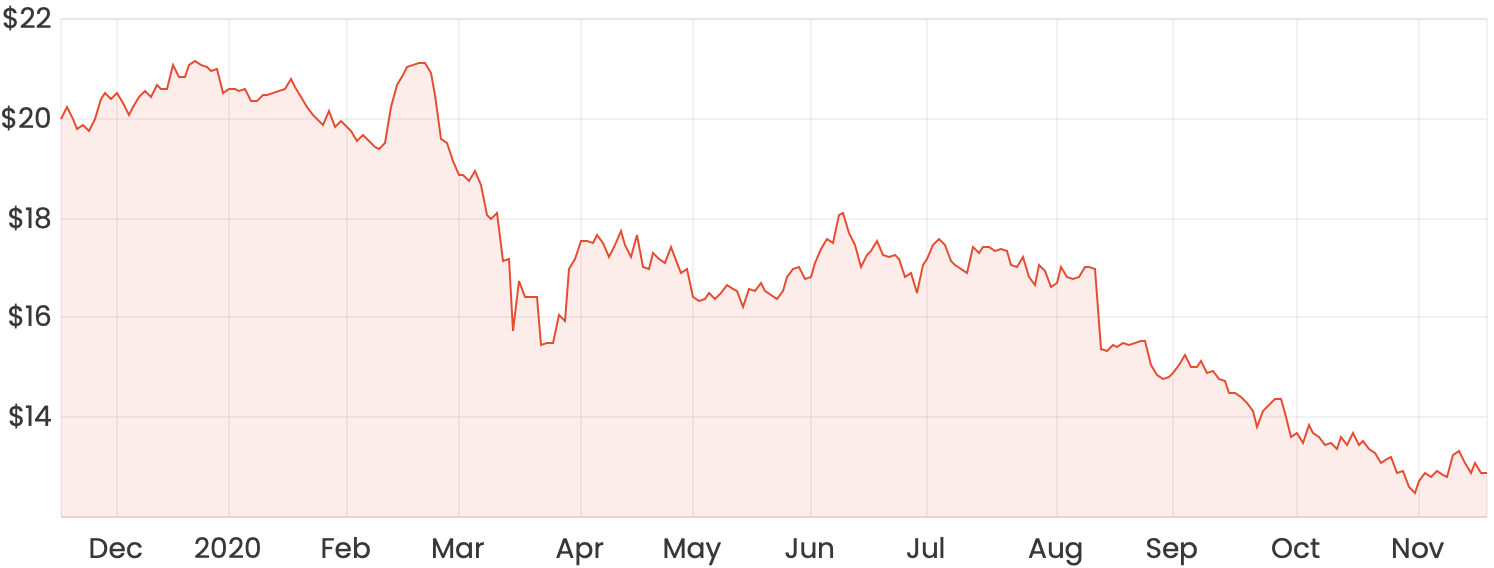The AGL Energy Limited (ASX: AGL) share price is down around 35% this year. Does the current AGL share price offer value?
AGL share price chart

AGL operates Australia’s largest electricity generation portfolio and provides 3.95 million gas, electricity, and telecommunications services to customers throughout Australia.
AGL’s FY20 result
In FY20, AGL achieved a statutory profit after tax of $1,015 million, up from $905 million in FY19. AGL attributed the increase to non-cash movement in the fair value of financial instruments.
AGL’s preferred measure of profit, underlying profit after tax, came in at $816 million, representing a 22% decrease from FY19. The company’s reasons for the fall included an unplanned outage at coal-fired power station Loy Yang, lower gas volumes, lower wholesale electricity and large scale generation certificate prices and higher depreciation and amortisation costs.
Net cash flow from operating activities after interest and tax increased 35% in FY20 to $2.156 billion. AGL utilised a chunk of its operating cash flow to complete a $622 million on-market share buy-back.
Headwinds continuing
In October this year, AGL held its annual general meeting (AGM).
At the virtual AGM, AGL provided FY21 guidance of underling profit after tax of $560 to 660 million. This would represent a steep fall in the range of 19%-31% from the underlying result of $816 million in FY20.
AGL CEO Brett Redman commented, “wholesale electricity prices, the single biggest driver of AGL’s profit, are substantially down”.
Brett continued, “we expect wholesale prices to recovery over time to levels more conducive to stimulating new investment, current economic condition and the uncertainty created by the COVID pandemic mean this recovery may take some time”.
AGL’s growth strategy
At AGL’s 2020 AGM, management commented on how it was executing its growth strategy through completing a series of acquisitions.
In AGL’s FY19 annual report, Chairman Graeme Hunt spoke on how this involved “optimising our existing portfolio for performance and value; evolving and expanding our core energy market offerings; and creating new opportunities with increasingly connected customers as data and energy value streams converge.”
Below is a quick summary of AGL’s recent acquisitions.
In August 2019, AGL acquired gas generation and business customer retailer Perth Energy for an enterprise value of $93 million. Perth Energy was 80% owned by Infratil Ltd (ASX: IFT) and 20% owned by Hoperidge Enterprises and other minority shareholders.
In October 2019, AGL revealed it had entered into a conditional agreement to acquire Southern Phone Company (SPC) for $27.5 million. SPC is one of Australia’s largest regional telecommunications businesses with 100,000 customers.
At the time of the SPC agreement being made, CEO Brett Redman said: “AGL’s first step into the broadband and data sector, which is part of our growth strategy, builds on our strong regional presence as an energy retailer and SPC’s telecommunication services and capabilities,”.
In August this year, AGL entered into an agreement to acquire electricity and gas retailer, Click Energy Group, for $115 million from Amaysim Australia Ltd (ASX: AYS).
Is the AGL share price a buy?
At first glance, AGL shares appear cheap, trading on a trailing dividend yield of 7.48%. However, AGL has braced the market to expect a disappointing FY21 result on the back of lower wholesale electricity prices. In other words, the high trailing yield appears to be a ‘dividend trap’.
I also believe AGL will face tough competition in the broadband and data sector from the likes of Telstra Corporation Ltd (ASX: TLS), TPG Telecom Ltd (ASX: TPG) and Aussie Broadband Ltd (ASX: ABB).









